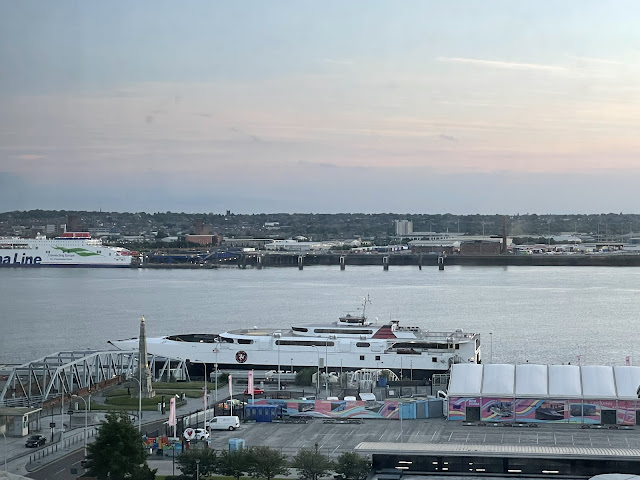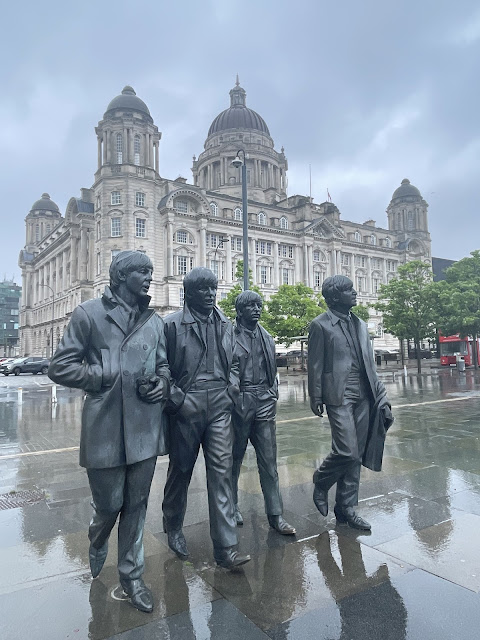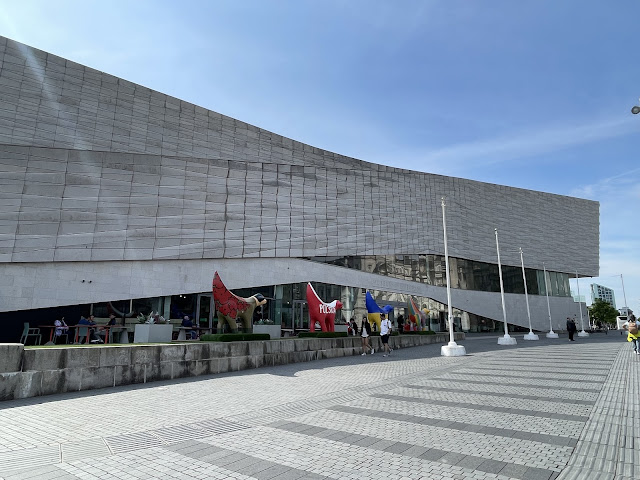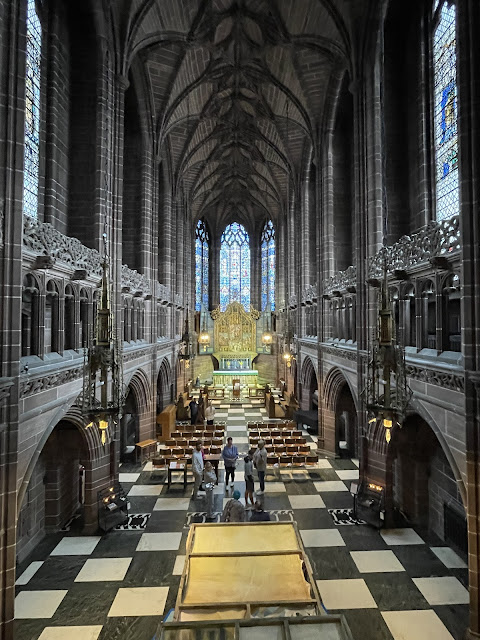Lime Street Station in Liverpool is the oldest continually used railway station in the UK, having opened in 1832.
We settled in at our hotel for the next two nights, chosen for its proximity to the ferry terminal to the Isle of Man.
It had quite a good view overlooking the Mersey River. That is the “Manannan”, which is the ferry we rode on to get to and from the Isle of Man. It was actually built in Tasmania.
The view at night is pretty good too.
As the weather was forecast to be wet on the Wednesday, we walked around the waterfront of the city, despite our eyes hanging out of our heads. Liverpool is such an interesting city with so much to see in a relatively small area.
Our first port of call was the Crowne Plaza Hotel, just over the road. We had stayed here a couple of times before, the last time being 2018, and wanted to say “Hi” to Frank the doorman. You can read the significance here. We weren’t sure if he would still be there or retired. He informed us that he was just about to turn 80 and still enjoying the job. And, yes as we walked in he greeted us with “Well, how are you two going?”.
We next visited the Beatles statue. As you can see, it was even warm enough to be in a t shirt.
The waterfront of Liverpool has an incredible amount of history, being one of England’s main ports until recent times. It was heavily bombed during WWII, but surprisingly, some of the major buildings remained standing. Probably the most famous is the Liver Building, with the Liver Birds on top of the towers. They have provided the Liverpool FC with their logo. The clock faces on the tower are the largest in the UK.
Next to it is the Cunard building, seen behind the Beatles.
Then the Port Authority building, seen behind the Beatles on the following morning, when the weather did change, as forecast.
Another historic building in the area is commonly known as the “Streaky Bacon Bulding”. Its proper name is “Albion House” and it was the headquarters for the White Star shipping line, owners of the Titanic.
There is also a very stunning art deco structure. To our surprise it is the ventilation shaft for the Queensway Tunnel under the Mersey River, constructed in the early 1930s. They don’t make them that attractive now.
The Albert Dock is now the home of the Tate Modern Gallery (currently being refurbished, so not open) and several restaurants and retail outlets.
It is also the home of the Mersyside Maritime Museum, which includes the International Slavery Museum, as most slaves that were shipped to the Americas were on Liverpool owned ships. We didn’t visit on that day, as it was something we could do if it was raining.
There are two docks in the area and these are the oldest surviving docks in Liverpool. They date back to the mid 1700s and were used to make repairs on the slave trade ships.
There are also a lot of modern buildings in the area, as much land has been reclaimed over the years and there have been modern buildings on the sites that were destroyed in WWII. The museum is one example.
We also came across a quirky upside down house being built. Not quite sure what this is about.
Mick was ready for a sit down after all our walking.
That was just about enough walking for one day, we were ready for an early night to catch up on some sleep.
The next day was wet, as expected, and windy. We left the hotel to find somewhere for breakfast and my umbrella was caught by a gust of wind and broke. Sad. It wasn’t heavy rain, so just our jackets were quite sufficient and to tell the truth, an umbrella would have been a nuisance. After a delicious breakfast we hopped on a double decker tourist bus and did a round of the city. No photos, as the windows were wet, but it was very interesting. We did a partial second loop, before hopping off and continuing our day on foot. I think we walked over 12kms, according to my phone.
Our first port of call was the Metropolitan Cathedral, affectionately known as “Paddy’s Wigwam”. (You have to visit a cathedral in England, don’t you.) It is the largest Catholic Cathedral in England. It has an interesting history.
In the late 1920s a prominent architect was commissioned to design a magnificent cathedral for Liverpool, to rival the Anglican one that was under construction. It would have been the second largest catholic cathedral, after St Peters in Rome. Work started on the crypt in 1931 and progressed until WWII stopped work. The crypt was completed. There is a scale model of the proposed cathedral in the Liverpool Museum.
After the war ended, there was a costing review and it was estimated that to complete the building would cost about 27 million pounds, which was out of the question. The bishop at the time was forward thinking and decided to have a competition to design a modern cathedral, to be completed in five years for less than one million pounds. This was achieved and the current cathedral was opened in 1967. A feature is the lead light lantern in the centre of the roof and blue lead light side lights.
There are a few beautiful textile wall hangings on the walls and a stunning pipe organ.
After visiting this cathedral, we headed over to the Anglican Cathedral. We enjoyed a nice lunch in their cafe.
I didn’t get a proper photo of the building, so will add this one from their brochure.
It is the largest cathedral in England and the fifth largest in the world, being the longest cathedral in the world. The bells in the tower are the highest and heaviest ringing peal of bells in the world.
The pipe organ is the largest in the UK, with the pipes located in various positions around the cathedral.
The building took 74 years to build and surprisingly, was started in 1904 and only finally completed in 1978. It was consecrated in 1924, so is celebrating that centenary next month. Both WWI and WWII caused delays in the building and there was bomb damage from WWII to be repaired. The architect was only 22 when his design won the competition for the design. He died in 1960, before seeing its completion.
The main altar cloth is beautiful.
This is the Lady’s Chapel, which was the first section completed in 1910. It features stained glass windows celebrating various successful women.
There is an illuminated Book of Remembrance in the Memorial chapel, written on vellum, listing 35,000 Liverpool locals who died in WW1 and WW2. It was being opened, as someone was searching for a particular person.
There is even a section for those who served with the Australian forces.
As with most cathedrals, the tiles had me fascinated.
Back outside we continued on our way and popped in to have a look at the Philharmonic Dining Rooms. This is a Grade 1 listed pub.
You can see why when you go inside.
We were told that you have to check out the men’s loos. (There are no old, original ladies’ loos as they weren’t permitted in the building.). We were also told that you have to hold your nose, what with it being a men’s loo. Well, Mick went in to take these photos and he was nearly retching. Even standing in the bar you could smell them. They may look fancy, but yuck!
Next, we walked down Rodney Street, which is the Harley Street of Liverpool.
It consists of lovely Georgian terraces, all with lovely front doors.
I think that is enough for one session. I’ll be back with more soon.














































7 comments:
So much of interest in Liverpool. We never made it to that city, I would have loved to see the Beatles statue. And I believe the Cabin where they used to play is still up and running. Have a wonderful trip, I'll be tagging along too.
OMG...........what an amazing post & so much I've never seen as we've either passed through or one time was to see our niece who lives in the vicinity. Everything made me smile & I love cathedrals, minsters, art deco buildings & oh, those tiles. Thanks so much. Take care & hugs.
So much to see! You certainly managed to get your daily steps in. Fascinating buildings....love the doorways, and the tiles.
Thanks for transporting me back in time to when I had the opportunity to attend a conference in Liverpool. Yes, I've visited most of the places you show but the dock was not visible as it is in your photo. Maybe it was full of water? Amazing to visit albeit virtually.
Oh your photos are wonderful . Loved the book of remembrance. My dads family name was there….
oh what a delightful post! i can see why the tiles were tantalizing you...there is definitely more than one quilt border there...and what a pub! pretty is isn't always pretty smells...LOL
So cool the ferry was built in Tasmania!! I love that you photographed he cute doors!
It is wonderful that Frank was still there and remembered you.
The streaky bacon building is so unique'.
Thank you for sharing your trip with us. I loved reading about the bits of history you shared as well.
Post a Comment